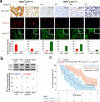Caveolin-1 temporal modulation enhances antibody drug efficacy in heterogeneous gastric cancer
- PMID: 35534471
- PMCID: PMC9085816
- DOI: 10.1038/s41467-022-30142-9
Caveolin-1 temporal modulation enhances antibody drug efficacy in heterogeneous gastric cancer
Abstract
Resistance mechanisms and heterogeneity in HER2-positive gastric cancers (GC) limit Trastuzumab benefit in 32% of patients, and other targeted therapies have failed in clinical trials. Using patient samples, patient-derived xenografts (PDXs), partially humanized biological models, and HER2-targeted imaging technologies we demonstrate the role of caveolin-1 (CAV1) as a complementary biomarker in GC selection for Trastuzumab therapy. In retrospective analyses of samples from patients enrolled on Trastuzumab trials, the CAV1-high profile associates with low membrane HER2 density and low patient survival. We show a negative correlation between CAV1 tumoral protein levels - a major protein of cholesterol-rich membrane domains - and Trastuzumab-drug conjugate TDM1 tumor uptake. Finally, CAV1 depletion using knockdown or pharmacologic approaches (statins) increases antibody drug efficacy in tumors with incomplete HER2 membranous reactivity. In support of these findings, background statin use in patients associates with enhanced antibody efficacy. Together, this work provides preclinical justification and clinical evidence that require prospective investigation of antibody drugs combined with statins to delay drug resistance in tumors.
© 2022. The Author(s).
Conflict of interest statement
The authors declare no competing interests.
Figures




Similar articles
-
Statins enhance the efficacy of HER2-targeting radioligand therapy in drug-resistant gastric cancers.Proc Natl Acad Sci U S A. 2023 Apr 4;120(14):e2220413120. doi: 10.1073/pnas.2220413120. Epub 2023 Mar 27. Proc Natl Acad Sci U S A. 2023. PMID: 36972439 Free PMC article.
-
HER2-Targeted PET Imaging and Therapy of Hyaluronan-Masked HER2-Overexpressing Breast Cancer.Mol Pharm. 2020 Jan 6;17(1):327-337. doi: 10.1021/acs.molpharmaceut.9b01091. Epub 2019 Dec 19. Mol Pharm. 2020. PMID: 31804840 Free PMC article.
-
Personalized therapeutic strategies in HER2-driven gastric cancer.Gastric Cancer. 2021 Jul;24(4):897-912. doi: 10.1007/s10120-021-01165-w. Epub 2021 Mar 23. Gastric Cancer. 2021. PMID: 33755862
-
Novel HER2-Targeting Antibody-Drug Conjugates of Trastuzumab Beyond T-DM1 in Breast Cancer: Trastuzumab Deruxtecan(DS-8201a) and (Vic-)Trastuzumab Duocarmazine (SYD985).Eur J Med Chem. 2019 Dec 1;183:111682. doi: 10.1016/j.ejmech.2019.111682. Epub 2019 Sep 6. Eur J Med Chem. 2019. PMID: 31563805 Review.
-
HER2 testing in gastric cancer.Adv Anat Pathol. 2011 Jan;18(1):53-9. doi: 10.1097/PAP.0b013e3182026d72. Adv Anat Pathol. 2011. PMID: 21169738 Review.
Cited by
-
[64Cu]Cu-NOTA-Trastuzumab and [89Zr]Zr-DFO-Trastuzumab in Xenografts with Varied HER2 Expression.Mol Pharm. 2024 Dec 2;21(12):6311-6322. doi: 10.1021/acs.molpharmaceut.4c00777. Epub 2024 Oct 29. Mol Pharm. 2024. PMID: 39471823 Free PMC article.
-
Caveolae: Metabolic Platforms at the Crossroads of Health and Disease.Int J Mol Sci. 2025 Mar 24;26(7):2918. doi: 10.3390/ijms26072918. Int J Mol Sci. 2025. PMID: 40243482 Free PMC article. Review.
-
Caveolin-1 knockout mitigates breast cancer metastasis to the lungs via integrin α3 dysregulation in 4T1-induced syngeneic breast cancer model.Cancer Gene Ther. 2024 Nov;31(11):1658-1668. doi: 10.1038/s41417-024-00821-4. Epub 2024 Sep 7. Cancer Gene Ther. 2024. PMID: 39244591 Free PMC article.
-
PCSK9 Promotes the Malignancy of Triple-negative Breast Cancer Cells by Reducing Cholesterol Levels at the Plasma Membrane to Activate EGFR and HER3.Adv Sci (Weinh). 2025 May;12(20):e2408514. doi: 10.1002/advs.202408514. Epub 2025 Apr 7. Adv Sci (Weinh). 2025. PMID: 40192514 Free PMC article.
-
Immuno-PET Detects Antibody-Drug Potency on Coadministration with Statins.J Nucl Med. 2023 Oct;64(10):1638-1646. doi: 10.2967/jnumed.122.265172. Epub 2023 Jun 29. J Nucl Med. 2023. PMID: 37385676 Free PMC article.
References
-
- Bang YJ, et al. Trastuzumab in combination with chemotherapy versus chemotherapy alone for treatment of HER2-positive advanced gastric or gastro-oesophageal junction cancer (ToGA): a phase 3, open-label, randomised controlled trial. Lancet. 2010;376:687–697. doi: 10.1016/S0140-6736(10)61121-X. - DOI - PubMed
-
- Tabernero J, et al. Pertuzumab plus trastuzumab and chemotherapy for HER2-positive metastatic gastric or gastro-oesophageal junction cancer (JACOB): final analysis of a double-blind, randomised, placebo-controlled phase 3 study. Lancet Oncol. 2018;19:1372–84.. doi: 10.1016/S1470-2045(18)30481-9. - DOI - PubMed
Publication types
MeSH terms
Substances
Grants and funding
LinkOut - more resources
Full Text Sources
Medical
Research Materials
Miscellaneous

